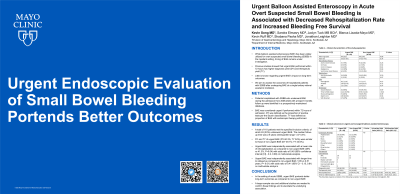Tuesday Poster Session
Category: GI Bleeding
P3457 - Urgent Balloon Assisted Enteroscopy in Acute Overt Suspected Small Bowel Bleeding Is Associated With Decreased Rehospitalization Rate and Increased Bleeding Free Survival
Tuesday, October 24, 2023
10:30 AM - 4:00 PM PT
Location: Exhibit Hall


Kevin Song, MD
Mayo Clinic College of Medicine
Bellevue, Washington
Presenting Author(s)
Kevin Song, MD1, Sandra Elmasry, MD2, Jaclyn Tuck, MBBCh2, Blanca Lizaola-Mayo, MD3, Kevin Ruff, MD4, Shabana Pasha, MD2, Jonathan Leighton, MD2
1Mayo Clinic College of Medicine, Bellevue, WA; 2Mayo Clinic College of Medicine, Scottsdale, AZ; 3Mayo Clinic, Phoenix, AZ; 4Mayo Clinic, Scottsdale, AZ
Introduction: While balloon assisted enteroscopy (BAE) has been widely utilized for overt suspected small bowel (SB) bleeding in the inpatient setting, timing of BAE remains under investigation. To date, there is no consensus on the optimal timing to perform BAE in patients with suspected SB bleeding. Previous studies showed that urgent BAE performed within 72 hours has higher diagnostic yield (DY) and therapeutic yield (TY). However, little is known regarding urgent BAE’s impact on long-term outcomes. . We aim to assess the outcomes of hospitalized patients with suspected SB bleeding after undergoing BAE at a single tertiary referral academic institution.
Methods: Patients hospitalized with suspected SB bleeding who underwent BAE during the admission from 2008-2022 with at least 6 months follow up were identified in a prospectively maintained database. Patients with incomplete follow up or procedure were excluded. Clinical characteristics were collected by chart review. BAE was considered urgent if performed within 72 hours of admission. DY was defined as the proportion of positive tests per the Saurin classification. TY was defined as proportion of BAE with endoscopic therapy performed. Variables were analyzed by Fisher’s Exact Test, Student’s T-Test, or multivariate logistic regression analysis where appropriate.
Results: A total of 118 patients met the specified inclusion criteria, of which 63 (53%) underwent urgent BAE. The median follow-up time was 2.8 years (interquartile range 1.37-4.91). Patient outcomes are displayed in Table 1. DY and TY of urgent BAE (DY 60.3%; TY 54%) were similar to those of non-urgent BAE (DY 49.1%; TY 43.6%). Urgent BAE was independently associated with a lower rate of rehospitalization as compared to non-urgent BAE (29% vs 41.3%, P=0.04) with odds ratio of 0.45 (96% confidence interval [CI] 0.2, 0.99). Likewise, urgent BAE was also independently associated with longer time to rebleed as compared to non-urgent BAE (1.85 vs 0.51 years, P< 0.01) with odds ratio of 0.41 (96% -CI 0.15, 0.81). Two patients died from their bleeding – one each after urgent and non-urgent BAE.
Discussion: In the setting of acute suspected SB bleeding, urgent BAE portends better long-term outcomes as compared to non-urgent BAE. Interestingly, both DY and TY were similar between urgent and non-urgent BAE. A larger sample size and additional studies are needed to confirm these findings and to elucidate the underlying association.
Disclosures:
Kevin Song, MD1, Sandra Elmasry, MD2, Jaclyn Tuck, MBBCh2, Blanca Lizaola-Mayo, MD3, Kevin Ruff, MD4, Shabana Pasha, MD2, Jonathan Leighton, MD2. P3457 - Urgent Balloon Assisted Enteroscopy in Acute Overt Suspected Small Bowel Bleeding Is Associated With Decreased Rehospitalization Rate and Increased Bleeding Free Survival, ACG 2023 Annual Scientific Meeting Abstracts. Vancouver, BC, Canada: American College of Gastroenterology.
1Mayo Clinic College of Medicine, Bellevue, WA; 2Mayo Clinic College of Medicine, Scottsdale, AZ; 3Mayo Clinic, Phoenix, AZ; 4Mayo Clinic, Scottsdale, AZ
Introduction: While balloon assisted enteroscopy (BAE) has been widely utilized for overt suspected small bowel (SB) bleeding in the inpatient setting, timing of BAE remains under investigation. To date, there is no consensus on the optimal timing to perform BAE in patients with suspected SB bleeding. Previous studies showed that urgent BAE performed within 72 hours has higher diagnostic yield (DY) and therapeutic yield (TY). However, little is known regarding urgent BAE’s impact on long-term outcomes. . We aim to assess the outcomes of hospitalized patients with suspected SB bleeding after undergoing BAE at a single tertiary referral academic institution.
Methods: Patients hospitalized with suspected SB bleeding who underwent BAE during the admission from 2008-2022 with at least 6 months follow up were identified in a prospectively maintained database. Patients with incomplete follow up or procedure were excluded. Clinical characteristics were collected by chart review. BAE was considered urgent if performed within 72 hours of admission. DY was defined as the proportion of positive tests per the Saurin classification. TY was defined as proportion of BAE with endoscopic therapy performed. Variables were analyzed by Fisher’s Exact Test, Student’s T-Test, or multivariate logistic regression analysis where appropriate.
Results: A total of 118 patients met the specified inclusion criteria, of which 63 (53%) underwent urgent BAE. The median follow-up time was 2.8 years (interquartile range 1.37-4.91). Patient outcomes are displayed in Table 1. DY and TY of urgent BAE (DY 60.3%; TY 54%) were similar to those of non-urgent BAE (DY 49.1%; TY 43.6%). Urgent BAE was independently associated with a lower rate of rehospitalization as compared to non-urgent BAE (29% vs 41.3%, P=0.04) with odds ratio of 0.45 (96% confidence interval [CI] 0.2, 0.99). Likewise, urgent BAE was also independently associated with longer time to rebleed as compared to non-urgent BAE (1.85 vs 0.51 years, P< 0.01) with odds ratio of 0.41 (96% -CI 0.15, 0.81). Two patients died from their bleeding – one each after urgent and non-urgent BAE.
Discussion: In the setting of acute suspected SB bleeding, urgent BAE portends better long-term outcomes as compared to non-urgent BAE. Interestingly, both DY and TY were similar between urgent and non-urgent BAE. A larger sample size and additional studies are needed to confirm these findings and to elucidate the underlying association.
Disclosures:
Kevin Song indicated no relevant financial relationships.
Sandra Elmasry indicated no relevant financial relationships.
Jaclyn Tuck indicated no relevant financial relationships.
Blanca Lizaola-Mayo indicated no relevant financial relationships.
Kevin Ruff indicated no relevant financial relationships.
Shabana Pasha: abbvie – Grant/Research Support. medtronic – Grant/Research Support.
Jonathan Leighton: ANX – Advisor or Review Panel Member. Braintree – Advisor or Review Panel Member. Fresenius Kabi – Advisor or Review Panel Member. SEI Healthcare – Advisor or Review Panel Member.
Kevin Song, MD1, Sandra Elmasry, MD2, Jaclyn Tuck, MBBCh2, Blanca Lizaola-Mayo, MD3, Kevin Ruff, MD4, Shabana Pasha, MD2, Jonathan Leighton, MD2. P3457 - Urgent Balloon Assisted Enteroscopy in Acute Overt Suspected Small Bowel Bleeding Is Associated With Decreased Rehospitalization Rate and Increased Bleeding Free Survival, ACG 2023 Annual Scientific Meeting Abstracts. Vancouver, BC, Canada: American College of Gastroenterology.
